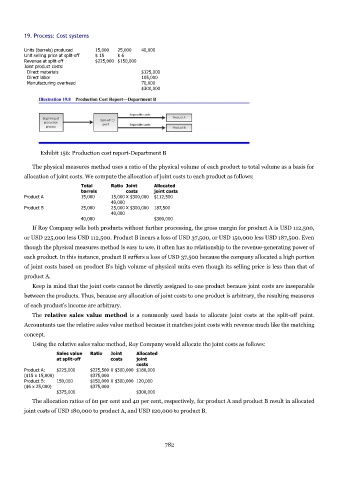Page 781 - Accounting Principles (A Business Perspective)
P. 781
19. Process: Cost systems
Units (barrels) produced 15,000 25,000 40,000
Unit selling price at split-off $ 15 $ 6
Revenue at split-off $225,000 $150,000
Joint product costs:
Direct materials $125,000
Direct labor 105,000
Manufacturing overhead 70,000
$300,000
Exhibit 156: Production cost report-Department B
The physical measures method uses a ratio of the physical volume of each product to total volume as a basis for
allocation of joint costs. We compute the allocation of joint costs to each product as follows:
Total Ratio Joint Allocated
barrels costs joint costs
Product A 15,000 15,000 X $300,000 $112,500
40,000
Product B 25,000 25,000 X $300,000 187,500
40,000
40,000 $300,000
If Roy Company sells both products without further processing, the gross margin for product A is USD 112,500,
or USD 225,000 less USD 112,500. Product B incurs a loss of USD 37,500, or USD 150,000 less USD 187,500. Even
though the physical measures method is easy to use, it often has no relationship to the revenue-generating power of
each product. In this instance, product B suffers a loss of USD 37,500 because the company allocated a high portion
of joint costs based on product B's high volume of physical units even though its selling price is less than that of
product A.
Keep in mind that the joint costs cannot be directly assigned to one product because joint costs are inseparable
between the products. Thus, because any allocation of joint costs to one product is arbitrary, the resulting measures
of each product's income are arbitrary.
The relative sales value method is a commonly used basis to allocate joint costs at the split-off point.
Accountants use the relative sales value method because it matches joint costs with revenue much like the matching
concept.
Using the relative sales value method, Roy Company would allocate the joint costs as follows:
Sales value Ratio Joint Allocated
at split-off costs joint
costs
Product A: $225,000 $225,500 X $300,000 $180,000
($15 x 15,000) $375,000
Product B: 150,000 $150,000 X $300,000 120,000
($6 x 25,000) $375,000
$375,000 $300,000
The allocation ratios of 60 per cent and 40 per cent, respectively, for product A and product B result in allocated
joint costs of USD 180,000 to product A, and USD 120,000 to product B.
782

